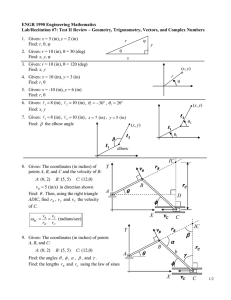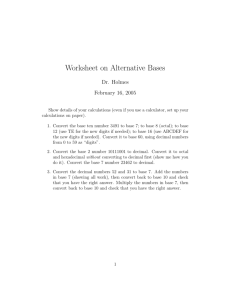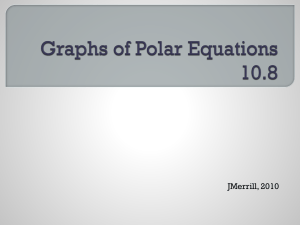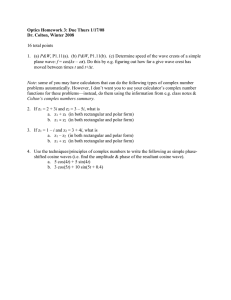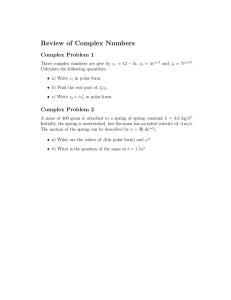Complex Number Calculations
advertisement
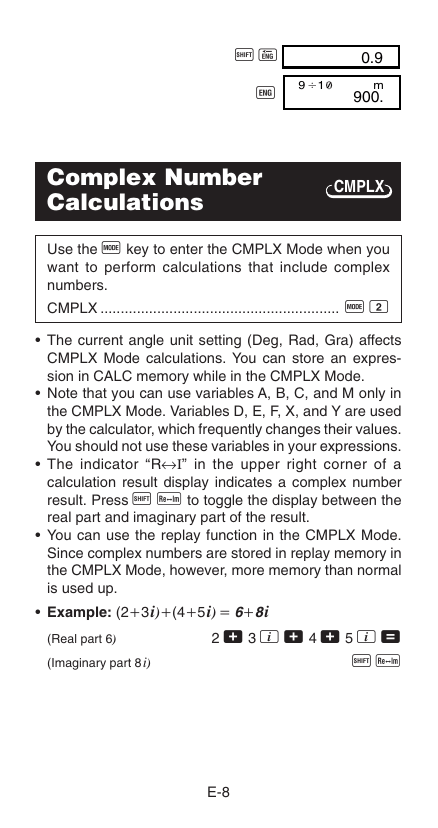
AP J Complex Number Calculations 0.9 9 ⫼1 m 900. CMPLX Use the F key to enter the CMPLX Mode when you want to perform calculations that include complex numbers. CMPLX ........................................................... F 2 • The current angle unit setting (Deg, Rad, Gra) affects CMPLX Mode calculations. You can store an expression in CALC memory while in the CMPLX Mode. • Note that you can use variables A, B, C, and M only in the CMPLX Mode. Variables D, E, F, X, and Y are used by the calculator, which frequently changes their values. You should not use these variables in your expressions. • The indicator “R↔I” in the upper right corner of a calculation result display indicates a complex number result. Press A r to toggle the display between the real part and imaginary part of the result. • You can use the replay function in the CMPLX Mode. Since complex numbers are stored in replay memory in the CMPLX Mode, however, more memory than normal is used up. • Example: (23 i)(45 i) 68 i (Real part 6) 2+3i+4+5i= Ar (Imaginary part 8 i) E-8 k Absolute Value and Argument Calculation Supposing the imaginary number expressed by the rectangular form z = a + bi is represented as a point in the Gaussian plane, you can determine the absolute value (r) and argument ( ) of the complex number. The polar form is r⬔. • Example 1: To determine the absolute value (r) and argument () of 3+4i (Angle unit: Deg) (r = 5, = 53.13010235°) Imaginary axis Real axis (r 5 ) ( 53.13010235 °) AAR3+4iT= AaR3+4iT= • The complex number can also be input using the polar form r⬔. • Example 2: 2 ⬔ 45 1 i (Angle unit: Deg) L 2 A Q 45 = Ar k Rectangular Form ↔ Polar Form Display You can use the operation described below to convert a rectangular form complex number to its polar form, and a polar form complex number to its rectangular form. Press A r to toggle the display between the absolute value (r) and argument ( ). • Example: 1 i ↔ 1.414213562 ⬔ 45 1+iAY=Ar L 2 A Q 45 A Z = A r (Angle unit: Deg) E-9 • You select rectangular form (a+bi) or polar form (r⬔ ) for display of complex number calculation results. F... 1(Disp) r 1(a+bi):Rectangular form 2(r⬔): Polar form (indicated by “r⬔ ” on the display) k Conjugate of a Complex Number For any complex number z where z = a+bi, its conjugate (z) is z = a – bi. • Example: To determine the conjugate of the complex number 1.23 + 2.34i (Result: 1.23 – 2.34 i ) A S R 1 l 23 + 2 l 34 i T = Ar Base-n Calculations BASE Use the F key to enter the BASE Mode when you want to perform calculations using Base-n values. BASE ........................................................ F F 3 • In addition to decimal values, calculations can be performed using binary, octal and hexadecimal values. • You can specify the default number system to be applied to all input and displayed values, and the number system for individual values as you input them. • You cannot use scientific functions in binary, octal, decimal, and hexadecimal calculations. You cannot input values that include decimal part and an exponent. • If you input a value that includes a decimal part, the unit automatically cuts off the decimal part. • Negative binary, octal, and hexadecimal values are produced by taking the two’s complement. E-10
